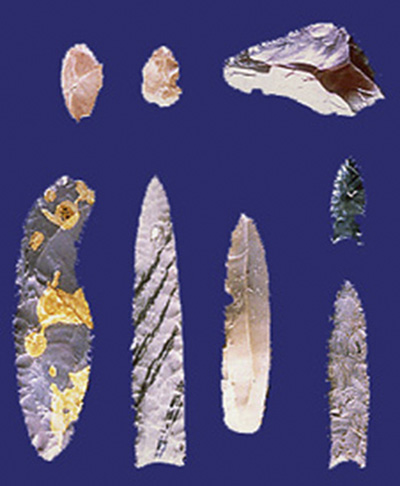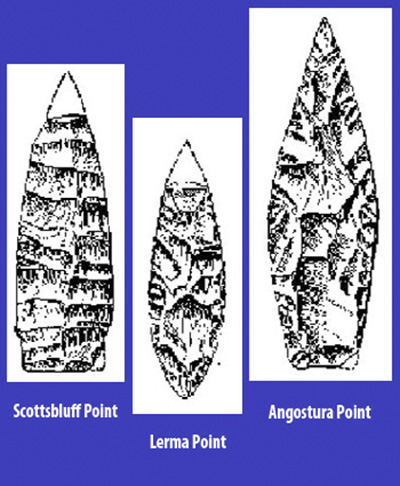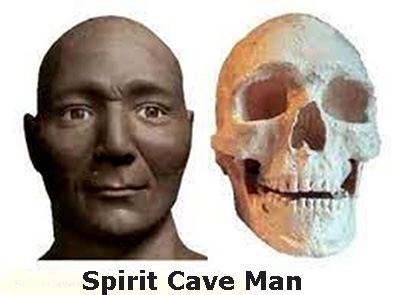Paleo-indian (Pre 7000 B.C.E.)
Hunters and Gathers
The traditional theory that the first Americans crossed the land bridge from Siberia to Alaska around 11,500 years ago and followed an "ice-free corridor" between two large Canadian ice sheets (the Laurentide and Cordilleran) to reach unglaciated lands to the south. These first inhabitants, whose archaeological sites are scattered across North and South America, were called the Clovis people, named after the town in New Mexico where their fluted spear points used for hunting mammoth were first found in 1932.
There is now convincing evidence of human habitation sites that date earlier than the Clovis culture including sites located in South America, dates 12,500 years ago. This site contains the buried remnants of dwellings, stone tools including large bifacial projectile points, and preserved medicinal and edible plants. How did people manage to settle this far south at such an early date? A coastal migration route is now gaining more acceptance, rather than the older view of small bands moving on foot across the middle of the land bridge between Siberia and Alaska and into the continents. Emerging evidence suggests that people with boats moved along the Pacific coast into Alaska and northwestern Canada and eventually south to Peru and Chile by 12,500 years ago or earlier. Archaeological evidence in Australia, Melanesia, and Japan indicate boats were in use as far back as 25,000 to 40,000 years ago. Sea routes would have provided abundant food resources and easier and faster movement than land routes. Many coastal areas were unglaciated at this time, providing opportunities for landfall along the way. Several early sites along the coast of Canada, California, Peru, Ecuador, and Chile date between 10,000 and 12,000 years ago.



If the Clovis people were not here first, then who was? Clovis points are found in many sites in North and Central America with a significant early cluster in the southeastern United States. Points similar to Clovis but without fluting and dating more than 12,000 years ago have been found in stratified archaeological sites in the eastern United States, such the Cactus Hill, Virginia. These finds have occurred because archaeologists are no longer halting their digging at the bottom of the Clovis level. So far scientists have found no technological affinities to relate Clovis to the Asian Paleolithic. However, Europe may have possible lithic precursors to Clovis. The Solutrean culture of western Europe, dating between 24,000 and 16,500 years ago, shows a similar lithic technology to that used to produce Clovis tools. The two cultures also share bone-shaping techniques, pebble-decorating artistry, the unusual tradition of burying stone tools in caches filled with red ocher, and other traits. In addition to archaeological research on ancient human sites, ancient skeletal remains show a range of physical attributes suggesting separate migrations of different populations of modern humans (Homo sapiens) from Asia. The handful of human skeletons dated over 8,000 years ago show some regional variation, but as a group their skulls differ markedly from the broad faces, prominent cheekbones, and round cranial vaults that characterize modern day American Indians. These ancient specimens have long and narrow cranial vaults with short and relatively gracile faces. Two examples are the 9,400-year-old Spirit Cave Man from Nevada and the most recently discovered 8.900-year-old Kennewick Man found in Washington State in 1996. Physical anthropologists see a greater similarity in these crania to certain Old World populations such as Polynesians, Europeans, and the Ainu of Japan. Only one early specimen, Wizards Beach Man, a Nevada skeleton dated to 9,200 years ago, falls within the range of variability of contemporary American Indians, an exception that requires further scientific validation. Crania with American Indian morphology appears by at least 7,000 years ago. The similarity of the ancient crania to Polynesians suggests that one early source of migrants to the Americas was Asian circumpacific populations. These populations were succeeded in Asia by the recent expansion of modern Mongoloids (i.e., Koreans, Japanese, Chinese, etc.), and in America by the ancestors of recent Native Americans. Whether individual skeletons or specific early groups were directly related to later peoples is unknown. Early migrants may have been replaced through competition or changed through gene flow by later arrivals. At this time, scientists are not ruling out the possibility of a migration from Europe.


Evidence for diverse migrations into the New World also comes from Mitochondrial DNA (mtDNA) research on living American Indian populations. These studies have consistently shown similarities between American Indians and recent populations in Asia and Siberia, but also unique American characteristics, which the very early crania have also shown. Evidence for only four mtDNA lineages, characterizing over 95 percent of all modern day American Indian populations, may suggest a limited number of founding groups migrating from Asia into the New World. Recently, however, a fifth mtDNA lineage named "X" has turned up in living American Indians and in prehistoric remains for which there does not appear to be an Asian origin. The first variant of X was found in Europeans and may have originated in Eurasia. Naturally, generations of conflict, intermarriage, disease, and famine would influence the genetic makeup of modern Native Americans. Further work with mtDNA, nuclear DNA (which is more representative of the entire genome), and Y-chromosome data, the male-transmitted complement of mtDNA, will permit better estimates of the genetic similarities between Old and New World groups and help to determine when they would have shared a common ancestor.
Scientists are examining archaeological, biological, and linguistic evidence to determine who the first Americans were, when they arrived in the New World, and what happened subsequently. New discoveries in one field of study can cause reinterpretations of evidence not only from the same field but also from other fields. There is no doubt that future discoveries and analyses, unbound from the Clovis limit, will shed more light on a changing picture of New World prehistory.
